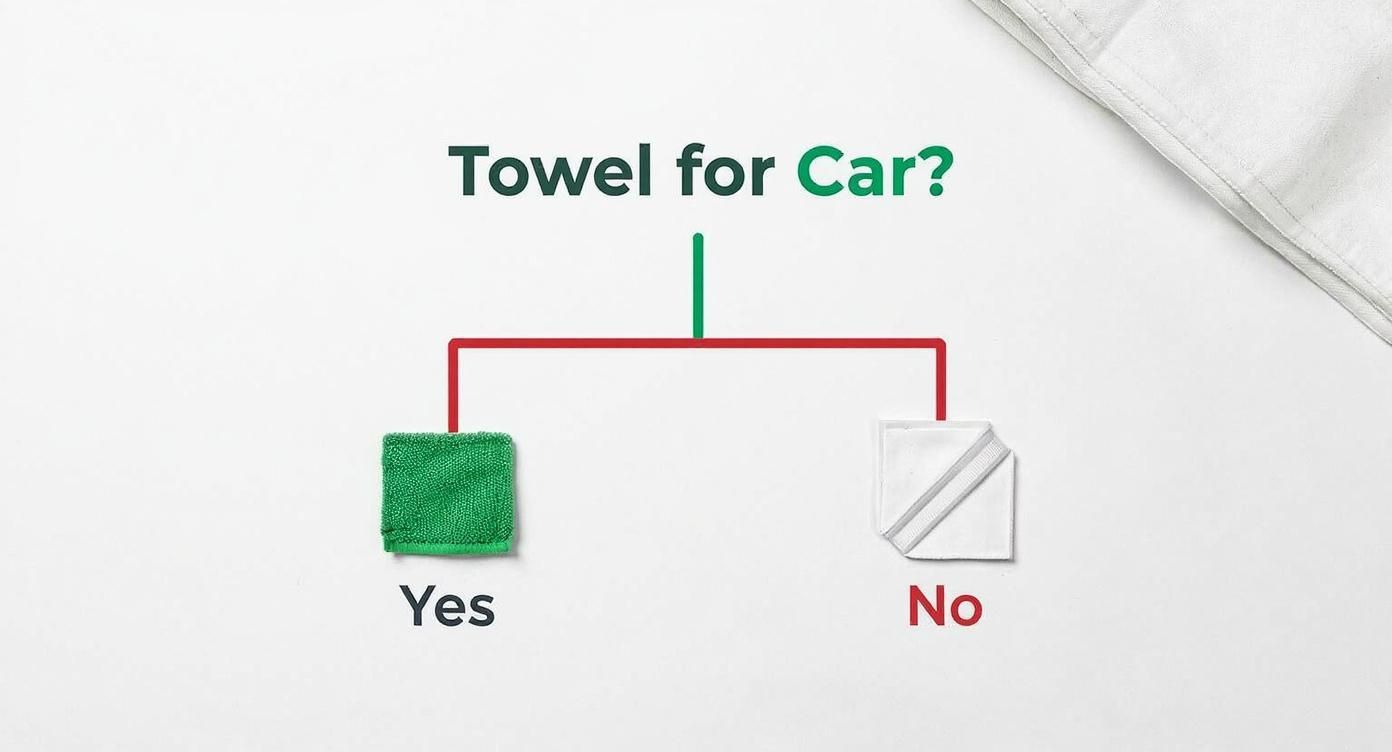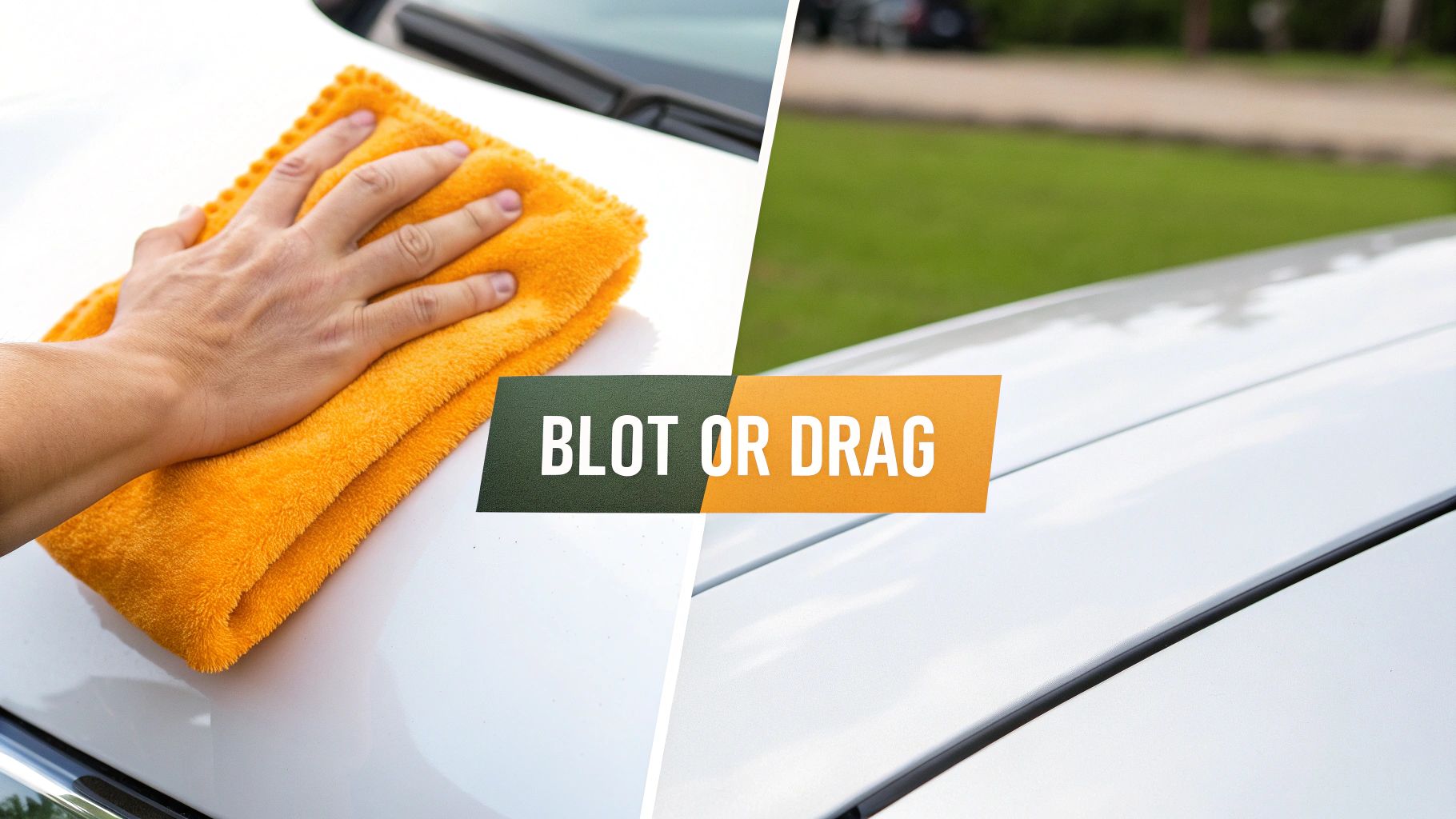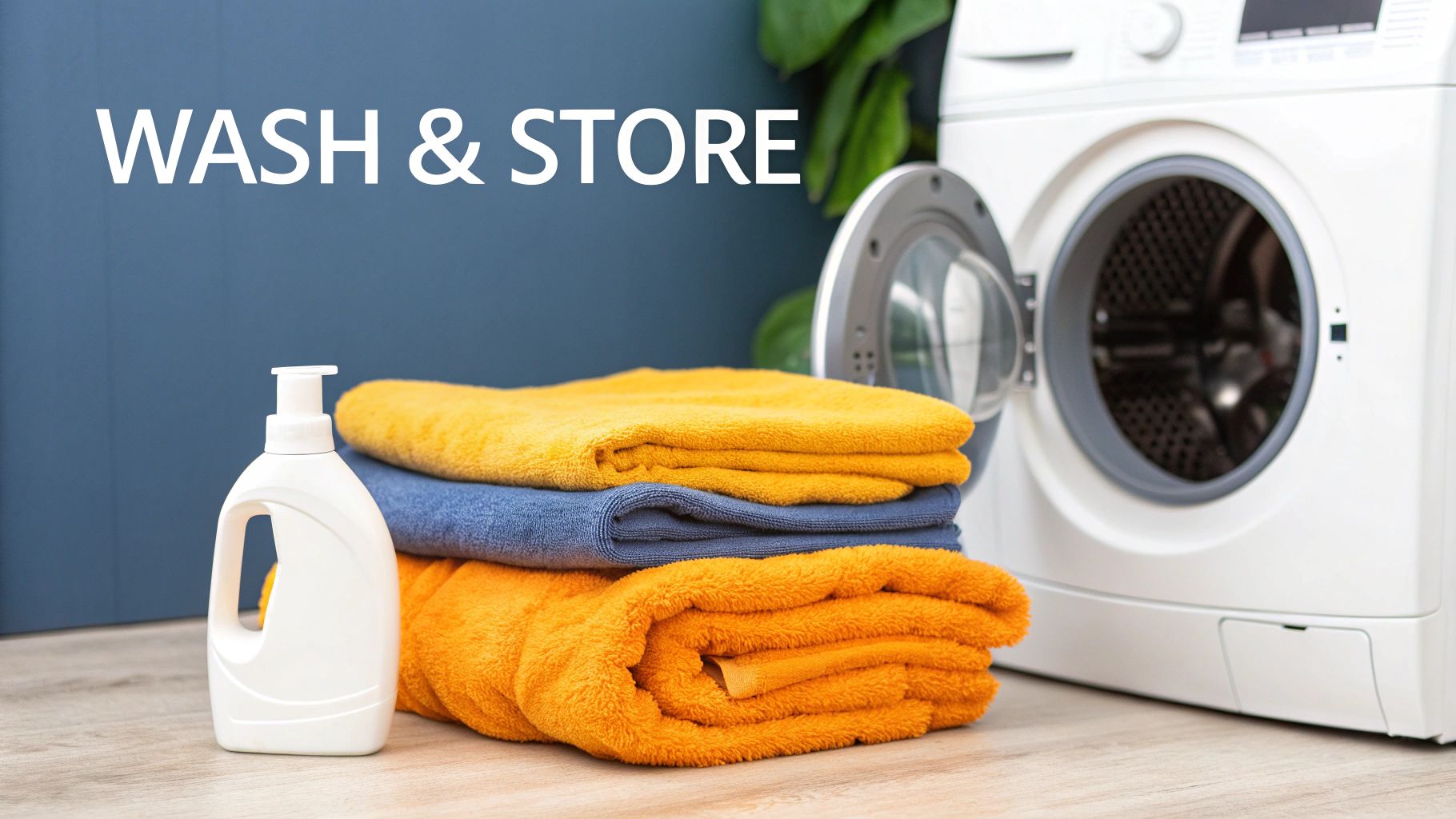You know that old bath towel you grab from the closet? We've all done it. It seems harmless enough, but it’s actually the secret villain behind those annoying swirl marks and fine scratches that mysteriously appear on your car's paint.
A purpose-built car wash drying towel isn't just a luxury—it's a necessity for a flawless finish. These towels are engineered with incredibly soft, absorbent fibers that gently lift water away, preventing the kind of abrasive damage that a standard cotton towel inflicts every time you use it. Honestly, choosing the right tool for drying is probably the single most important step you can take to keep your finish looking brand new.
The Hidden Damage in Common Towels
It’s easy to think that any absorbent cloth will work after a good wash, but what’s really happening at the surface level is pretty grim for your paint. Your typical bath or kitchen towel has a coarse, flat weave. When you drag that across your car's delicate clear coat, it doesn't just absorb water; it pushes around any microscopic contaminants left behind.
Think of it like dragging a piece of ultra-fine sandpaper across your paint. That’s a perfect analogy for what's happening. Every tiny speck of dirt or grit that wasn't rinsed off gets caught in those rough cotton fibers and becomes a tiny weapon, etching a web of fine scratches into your finish.
Why Microfiber Is the Only Way to Go
This is where a proper car wash drying towel, made from microfiber, completely changes the game. These towels are woven from millions of synthetic fibers that are unbelievably fine—often split to create a cross-section that looks like a star under a microscope. This unique structure gives the towel two huge advantages:
- Insane Absorbency: Those millions of fibers create a massive surface area that can soak up to seven times its own weight in water. It pulls moisture off the car, rather than just smearing it around.
- A Magnet for Grime: The split fibers act like tiny hooks, grabbing any leftover dirt particles and pulling them deep into the towel's pile, safely away from your paint's surface.
That's it. A simple switch in your drying tool can make a world of difference in preventing new paint defects. Instead of causing damage every time you wash, you’re actively protecting your car’s shine and value. And if you've already been using the wrong towels, it’s worth learning how to remove swirl marks from car paint to get a fresh start.
You don't have to just take my word for it—the entire industry has shifted. The market for specialized drying towels was valued at USD 1.5 billion in 2022 and is expected to rocket to nearly USD 2.8 billion by 2030. That kind of growth shows just how many car owners are waking up to the importance of using the right tools for the job. You can find more market insights over at aosehometex.com.
Picking the Right Towel: Twisted Loop vs. Waffle Weave
Walking down the car care aisle can feel like a pop quiz you didn't study for. So many towels, so many choices. But when it comes to drying your car, it really boils down to two main players: the twisted loop and the waffle weave. Each one is a specialist, and knowing when to use which will make your life a whole lot easier and your car a lot shinier.
At first glance, you can see they're built differently. A twisted loop towel has these long, thick, almost noodle-like fibers. It’s designed for one thing: to drink up a massive amount of water. Then you have the waffle weave, with its signature grid of little pockets. This one is all about getting that perfect, streak-free finish, especially on tricky spots like glass.
The Heavy Hitter: Twisted Loop Towels
Think of the twisted loop as your first-string player, the one you send out to do the heavy lifting. If you're tackling a big vehicle like a truck or an SUV, this is your best friend. Its super-plush, dense construction allows it to soak up a shocking amount of water.
Honestly, the technique is simple. Just lay a large twisted loop towel flat across your roof or hood, gently pull it towards you, and watch it suck up nearly every drop in one go. This is why so many of us love them—they get the bulk of the car dry in record time, so you're not wringing out a towel every 30 seconds.
The Finishing Pro: Waffle Weave Towels
Once the twisted loop has done its job, it's time to call in the closer. The waffle weave is your detailing specialist. Those little pockets in the weave are perfect for trapping those last few stubborn water droplets and wiping away any faint streaks left behind.
This makes it the absolute king for drying windows, mirrors, and chrome trim. You get a perfectly clear, flawless finish without any fuss.
Pro Tip: I never use the same towel for my paint and my glass. Waffle weave towels are great because they barely leave any lint, which means your windows will be crystal clear without those annoying little fibers clinging on for dear life.
The numbers back this up, too. Lab tests show that high-quality twisted loop towels can absorb anywhere from 800 to 1200 milliliters of water. That's often enough to dry the entire roof of a mid-size sedan in a single pass. In comparison, waffle weave towels absorb less—around 400-600 mL—but their structure is what delivers that pristine, streak-free surface. If you want to dive deeper into towel absorbency, the folks at beyondbraid.com have a great breakdown.
Still not sure which one to grab? This decision tree makes it pretty straightforward.

To make the choice even clearer, let's break down the main differences side-by-side.
Towel Weave Comparison Twisted Loop vs Waffle Weave
| Feature | Twisted Loop Towel | Waffle Weave Towel |
|---|---|---|
| Primary Use | Bulk water removal on large body panels | Streak-free finishing on glass, chrome, and trim |
| Absorbency | Extremely High: Can hold several times its weight | Good: Absorbs well but is designed for lighter work |
| Best For | Quickly drying the roof, hood, and doors | Achieving a perfect, lint-free shine on windows |
| Feel | Thick, plush, and heavy | Lightweight and textured with a distinct grid pattern |
| Potential Drawback | Can be heavy when fully saturated | Not as effective for the initial, heavy drying stage |
The most important thing to remember is to never grab an old bath towel from the house. They're too abrasive and will leave tiny scratches on your paint.
The best strategy? Use both. Start with a large twisted loop to get the majority of the water off your car's body, then follow up with a waffle weave for the windows and a final touch-up. It's the one-two punch for a perfect, spot-free finish every time.
Mastering Your Car Drying Technique
Having a top-tier drying towel is a great start, but it's your technique that truly separates a good finish from a flawless one. The right moves not only prevent scratches but also slash your drying time, leaving nothing behind but a mirror-like shine. It’s all about working smarter, not harder.
The first rule of drying is simple: work from the top down. Gravity is on your side, so let it help you. Start with the roof, then hit the glass, hood, and trunk. By working your way down the panels, you ensure any drips fall onto a wet area, not one you just finished. The dirtiest parts, like the lower doors and bumpers, should always be saved for last.

The Drag Method for Large Panels
When you get to the big, flat surfaces like the roof or hood, the "drag" method is your best friend for speed and efficiency. Open up your large drying towel and lay it completely flat across the panel. Now, just take the two corners closest to you and gently pull the towel straight back in one smooth motion.
It’s almost shocking to see how a high-quality towel can wick away virtually all the water in a single pass. The weight of the towel provides all the pressure you need—don't push down! Applying pressure creates friction and is the easiest way to drag a missed piece of grit across your beautiful paint.
Pro Tip: Let the towel do the work. Your job is to simply guide it across the surface, not scrub with it. This one small adjustment is a game-changer for preventing swirl marks, especially on those notoriously soft clear coats.
The Blotting Technique for Delicate Areas
For trickier curved areas, cars with very soft paint, or a freshly applied ceramic coating, blotting is the safest approach. Instead of dragging, you’ll gently lay the towel on a section and pat the water up.
Fold your towel into a plush, cushioned square. This method might take a few extra moments, but it's the gentlest way to dry a car, making it the go-to for show cars and anyone obsessive about perfect paint.
Avoiding Cross-Contamination
This is a big one. You absolutely must use a separate, designated towel for the lower sections of your vehicle. Think about it: the rocker panels, bumpers, and lower doors are constantly blasted with road grime and brake dust. Using the same towel on your hood that you just used down there is asking for scratches.
Here’s a simple system I always follow:
- Towel #1 (Primary): My best, plushest towel is reserved for the upper two-thirds of the car—the clean zones.
- Towel #2 (Secondary): A different, dedicated towel is used only for that grimy lower third.
- Towel #3 (Dirty Work): Never, ever use a paint towel on wheels or door jambs. Grab an older, retired microfiber towel for those jobs.
Sticking to this separation is a non-negotiable step for achieving professional results. When you master these techniques, you're no longer just washing your car; you're actively protecting its finish. For even more tips, take a look at our complete guide on the best way to dry car after washing for a spotless finish.
How to Care for Your Microfiber Towels
Think of that high-quality car wash drying towel as a crucial investment in your car's paint job. Just like any other precision tool in your garage, it needs proper care to keep performing at its peak. If you neglect it, those ultra-soft fibers can get clogged with gunk, stiffen up, and go from being your paint's best friend to a scratch-inducing nightmare.

The number one mistake I see people make is just chucking their detailing towels in with the family laundry. This is a fast track to ruin. When you mix them with cotton t-shirts and jeans, lint gets trapped deep in the microfiber's weave. The result? Nasty streaks and a towel that just pushes water around instead of absorbing it. Always, always wash your towels in their own separate load.
The Right Way to Wash and Dry
For the best possible results, you really should use a detergent made specifically for microfiber. These cleaners are designed to break down tough stuff like car wax, sealants, and road grime without leaving any residue behind that could damage the fibers. In a pinch, a clear, liquid laundry detergent that's totally free of dyes and perfumes can work.
Here’s the laundry recipe for keeping your towels safe and effective:
- Water Temperature: Stick with warm water, not hot. Overly high heat can cook the delicate synthetic fibers over time.
- Detergent: Just a small amount of a dedicated microfiber wash is all you need.
- Cycle: Choose a gentle or delicate cycle. Less aggressive agitation is better.
When it's time to dry, remember that low and slow is the way to go. Tumble dry on the absolute lowest heat setting your dryer has. Even better, just let them air dry. Too much heat will literally melt the fibers, making them hard, scratchy, and completely useless for drying a car.
Never, ever use fabric softener or dryer sheets. This is the golden rule. These products coat the fibers in a waxy, oily film that instantly clogs the microfiber, completely destroying its ability to absorb water.
Storing for Longevity
Once your towels are perfectly clean and bone dry, fold them neatly and put them away in a clean, sealed container. A plastic storage bin or a dedicated drawer works perfectly.
Don't just leave them sitting on a shelf in the garage. They'll just become magnets for dust and other airborne contaminants that you'll end up grinding into your car's finish next time you wash it. Proper storage means your towel is always pristine and ready to go.
For a deeper dive, check out our complete guide on how to wash car microfiber towels.
Common Car Drying Mistakes You Need to Avoid
Even if you've got the best car wash drying towel money can buy, a few common slip-ups can leave you with frustrating water spots and fine scratches. We've all been there. The good news is these mistakes are surprisingly easy to fix once you know what to watch out for.
https://www.youtube.com/embed/ejP1NJe9UVc
One of the absolute biggest culprits? Drying your car in direct sunlight. The sun's heat is your enemy here, causing water to evaporate way too fast and leave behind those stubborn mineral deposits we all know as water spots.
Always, and I mean always, pull your car into the garage or at least a shady spot before you even think about drying. This one simple move buys you the time you need to get a perfect, spot-free finish.
Relying On a Single, Soaked Towel
Another classic mistake I see all the time is trying to dry the entire car with just one towel. A high-quality microfiber towel is incredibly absorbent, but it has its limits. Once it's completely soaked, it stops pulling water off the paint.
Instead, you just end up pushing dirty water around the surface. That’s a surefire way to re-introduce tiny bits of grit you just washed off, which is how you get those annoying swirl marks.
A single, top-tier towel can be fully saturated after just a couple of large panels, like the roof and hood. The pro secret? Always have a second, perfectly dry towel ready to go for a flawless finish.
This is exactly why working with at least two towels is a game-changer. Here's a simple way to approach it:
- Your Workhorse Towel: Use your main towel to soak up the bulk of the water on the large, upper panels.
- Your Finishing Towel: Grab that fresh, dry towel for the lower parts of the car (which are often the dirtiest) and to do one final, streak-free pass on every other surface.
Got Questions About Car Drying Towels? We've Got Answers.
Even after you've nailed down the right drying technique, a few questions always seem to come up. Getting those lingering details sorted out is the final piece of the puzzle for a perfect, streak-free finish. Let's dig into some of the most common ones I hear from fellow car enthusiasts.
How Many Towels Do I Really Need?
This is probably the most frequent question I get. For most cars, sedans, or standard SUVs, two large, high-quality drying towels are the magic number.
My go-to method is to use the first towel for the top half of the car—the hood, roof, trunk, and upper door panels. These areas are usually the cleanest. Then, I grab the second towel for the lower, grittier sections. This simple trick keeps you from accidentally dragging road grime from your rocker panels all over your hood.
What's This "GSM" I Keep Seeing?
You'll see GSM mentioned everywhere, and it simply stands for Grams per Square Meter. Think of it as a measure of the towel's density and plushness.
When you're shopping for a car wash drying towel, you want to see a high GSM, typically in the 900-1200 range. A higher number means a thicker, plusher, and more absorbent towel that's much safer on your car's delicate clear coat.
Can I Just Use One Towel for the Whole Car?
It's tempting to simplify, but please don't. Your main drying towel should only ever touch your car's paint.
Once you use a towel on wheels, door jambs, or exhaust tips, it's permanently retired from paint duty. The risk of dragging brake dust or sharp debris across your finish is just too high.
My best piece of advice: Keep your tools separate. A dedicated, top-tier towel just for paint is an absolute must-have. Compromising here is how you end up with frustrating micro-scratches and swirls.
This focus on specialized tools is a growing trend. The car drying towel market was valued at around USD 150 million in 2024 and is expected to keep climbing as more people learn how to care for their vehicles properly. You can see the full market analysis on verifiedmarketreports.com.
For a wash that protects your paint from start to finish, the right tools make all the difference. SwiftJet designs solutions that work hand-in-hand with premium towels for a perfect result every time. See what you've been missing at https://swiftjetusa.com.
